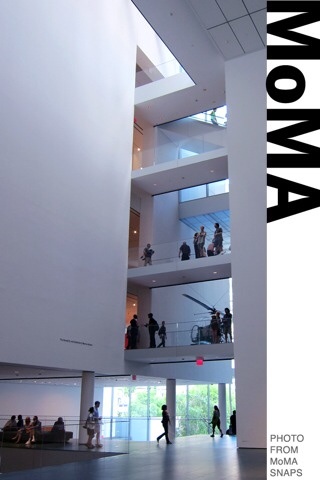 This was my fourth visit to MOMA, on October 7, 2013. I went with my family to Eastern Europe for two weeks and then ended in New York City where we stayed for a few days. We shopped, ate (a lot) and visited the museums. We only managed to visit two museums this time: MOMA and the Metropolitan Museum of Art. Both are my favorite museums.
This was my fourth visit to MOMA, on October 7, 2013. I went with my family to Eastern Europe for two weeks and then ended in New York City where we stayed for a few days. We shopped, ate (a lot) and visited the museums. We only managed to visit two museums this time: MOMA and the Metropolitan Museum of Art. Both are my favorite museums.
There were two new “discoveries” (to me) when we visited MOMA this time. When we arrived, the line to buy tickets was so long that we nearly wanted to quit. luckily, my sister from Canada is a volunteer in a museum. I went forward to ask the lady at the entrance. She said, ” Go ahead to the Information Desk”. There we went. She showed her identity card, and in a second she got two free tickets! Not only were we admitted free, we did not have to wait in line for one hour! What a pleasant surprise! I have to thank my sister for bringing her card and myself for having the courage to ask. Volunteering is a civic engagement and should be considered by everyone. I am not aware of this kind of benefits till that day. How encouraging!
My second “discovery”: I found out that there is a MOMA app on my iPhone, which includes many functions. It does not only function as an audio-guide like the other audio-guide that you rent from the museums. It also has a new feature called MOMA Snaps. You can snap a picture of the beautiful artwork and create a postcard with the name of MOMA.
This is the first time I took pictures of paintings in a museum. I told myself: MOMA asked me to do that, via the app! What a change of approach! I never dared raise my camera in a museum although lots of tourists did that. I did not do very well in manipulating the app. Please disregard the irregularities.
These are three paintings of Picasso that I really like. I took the photos and use the app to create a post-card like image.
♦♦♦♦♦
Pablo Picasso, The Three women at the Spring, 1921.
The first painting is called The Three women at the Spring, 1921.You may like to check the MOMA website for more detailed information about this painting.
http://www.moma.org/collection/object.php?object_id=79762
Audio Program excerpt
“February 13 – May 19, 2003“Curator, Kirk Varnedoe: When you look at Picasso’s Three Women at the Spring this represents the embodiment of what one calls the return to order—the idea that after World War I, French society wanted to reestablish its roots with the grand tradition and a kind of solid, reassuring, sculptural vision of the human figure rooted in classicism. It was an art of reassurance, of regrounding after the experimentation of the teens. And yet when you look at this picture, it’s not really a conservative picture—the tubular nature of the arms, the large abstract rhythms of the figures are very much a legacy of his more radical work.
Remember again that this is painted exactly in the same summer that he paints The Three Musicians. Unlike Matisse, Picasso is happy working in two extremes virtually simultaneously, painting a picture of strong Cubist abstraction on the one hand,and seemingly full bodied sculptural realism on the other.”
Pablo Picasso, The Three women at the Spring, 1921.
♦♦♦♦♦
Pablo Picasso. Les Demoiselles d’ Avignon, Paris, June-July, 1907.
The second painting is called Les Demoiselles d’ Avignon. It is a significant piece painted by Picasso during his African Influenced Period, which marked the beginning of Cubism, a very important art movement. The MOMA mobile website and the wiki site have some introductory descriptions which are very helpful to have some basic idea about this painting.
http://www.moma.org/m#object_79766
http://en.wikipedia.org/wiki/Les_Demoiselles_d%27Avignon
“Les Demoiselles d’Avignon (The Young Ladies of Avignon, and originally titled The Brothel of Avignon)[2] is a large oil painting created in 1907 by the Spanish artist Pablo Picasso (1881–1973). The work portrays five nude femaleprostitutes from a brothel on Carrer d’Avinyó (Avinyó Street) in Barcelona. Each figure is depicted in a disconcerting confrontational manner and none are conventionally feminine. The women appear as slightly menacing and rendered with angular and disjointed body shapes. Two are shown with African mask-likefaces and three more with faces in the Iberian style of Picasso’s native Spain, giving them a savage aura. In this adaptation of Primitivism and abandonment ofperspective in favor of a flat, two-dimensional picture plane, Picasso makes a radical departure from traditional European painting. The work is widely considered to be seminal in the early development of both cubism and modern art. Demoiselles was revolutionary and controversial, and led to wide anger and disagreement, even amongst his closest associates and friends.”
I also found the information on wiki very helpful to understand the influence of El Grecco ( The Opening of the Fifth Seal, (Apocalyptic Vision of Saint John) (1608–1614). ) has been suggested as a source of inspiration for Picasso’s Les Demoiselles d’ Avignon.) and Cezanne (Paul Cézanne‘s Les Grandes Baigneuses 1906, Philadelphia Museum of Art) is generally believed to be a likely inspiration for Les Demoiselles).
Pablo Picasso. Les Demoiselles d’ Avignon, Paris, June-July, 1907.
♦♦♦♦♦
Pablo Picasso, Girl Before a Mirror, 1932.
The third painting is called “Girl Before a Mirror”, 1932. The model was Picasso’s young mistress Marie-Therese Walker.
http://www.moma.org/m#object_78311
Curator Emeritus, John Elderfield said in the Audio Program, 2008, “Of all the women that Picasso painted, I think the images of Marie-Therese Walter are the most extraordinary.” I do agree with him. Whether you like this painting or not, it is very special!
In fact, I found this article very interesting:
” In Picasso: Girl before a Mirror,a new volume in the MoMA One on One series, curator Anne Umland uses an X-ray of the Cubist painting to uncover a new layer for interpretation.
X-ray of Girl before a Mirror, Taken in 2011
The painting, one of the most extraordinary works by Pablo Picasso in the Museum’s collection, is an unusual and captivating take on the traditional artistic theme of a woman looking into a mirror. The X-ray reveals that Picasso had originally portrayed the girl’s body in a far more naturalistic way, with curved hips and with her back toward the viewer. Why then did he opt to transform her into the decidedly geometric figure we see in the final product? The following comment, made by the artist himself, may shed some light on his methodology: “There is no abstract art. You must always start with something.” His changes sever any lingering connection with observed reality and bring her into Picasso’s shape-shifting world, her body now made of triangles and circles, allowing simultaneous back and side views.
This quite literal “behind-the-scenes” glance into Picasso’s process is but one of the many ways that the book, like others in the One on One series, offers a unique and comprehensive understanding of one of the most beloved works in MoMA’s collection.”
Pablo Picasso, Girl Before a Mirror, 1932.
♦♦♦♦♦
Which of these three paintings I like most? To me, the subject matter is very important when I appreciate art. As Les Demoiselles d’ Avignon is about prostitutes, and about cubism, which is not my most favorite period in Picasso’s paintings.
I am more interested in the Three women at the Spring. If you recall some time ago on this blog, I discussed about another painting of Picasso:
Pablo Picasso
Mother and Child, 1921, The Art Institute of Chicago
As to the Girl painting, The love affair between this young girl and the famous artist, is intriguing, like reading a novel. However what is most interesting to me about this painting is the analysis: Did the artist see through this girl? And what did he see?

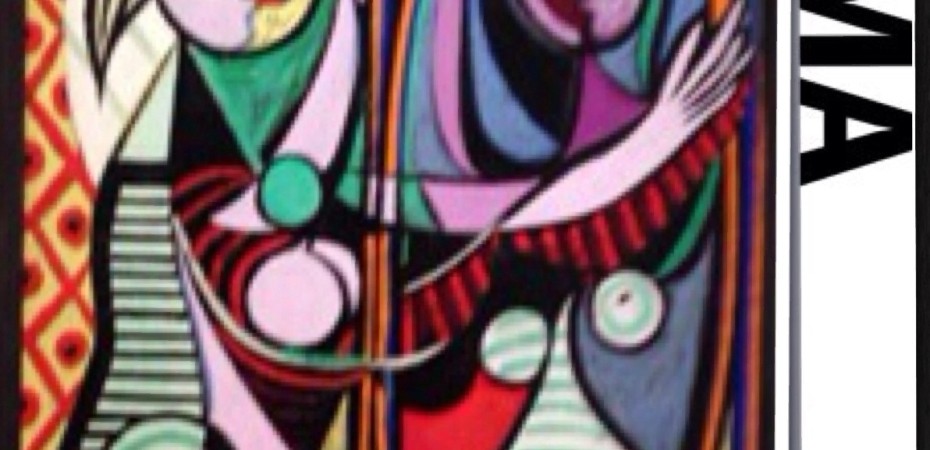
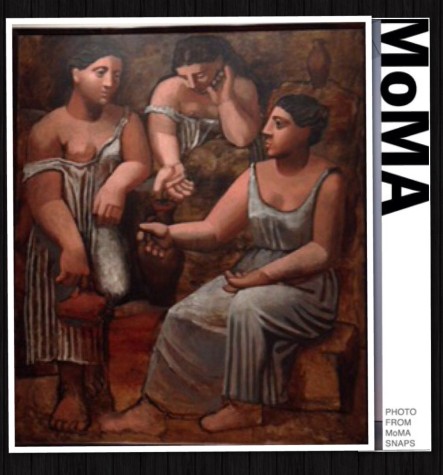
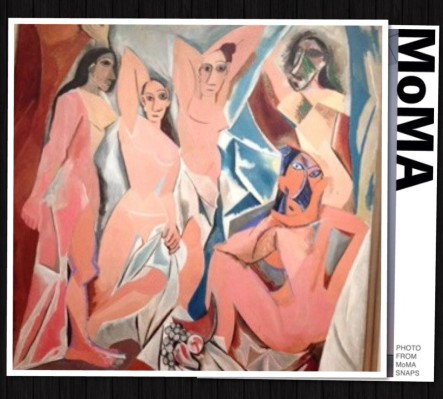

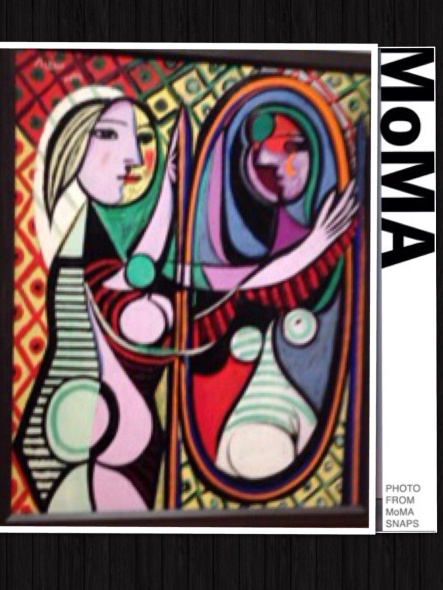
Reblogged this on My Notebook.
LikeLike
Denise – sounds like a magnificent trip you’ve had! I do love MoMA and understand completely what you mean about the long lines. Glad you were able to use that new MoMA app and further enjoy the Picasso pieces. Thank you for your visit to my blog also earlier today – always great to hear from you!
LikeLike
Thanks so much for stopping by and your comments. MOMA and The Met are as wonderful. I had attended a docent tour of Islamic art at the MET. It was eye opening for me.
LikeLike
These are beautiful paintings of Picasso and thank you for sharing. I remember reading and liking his painting about the girl in a pony tail. I’ll check the website from your link. Great literature and ark work!
LikeLike
Thanks so much, Seeker. There are lots of things to see and appreciate at MOMA. the website has lots of educational materials too. Glad that you like them. I bought the Girl poster long time ago. But it was too big to post anywhere. I couldn’t find it now!
LikeLike
All three painting are great. Well, Les Demoiselles d’ Avignon are probably one of the most important painting in art history, but…
I think, my favourite is the last one 🙂
Very interesting x-ray – very useful information – thanx!
And very nice story about free tickets 😉
I like your post very much!
LikeLike
Thanks so much for visiting my post and your comments. I had to go to MOMA for the third time before I could see this important and famous painting of Picasso: Les Demoiselles d’Avignon. It was always on the road . Like you, I like the Girl pix more. But the three women pix is my favorite among the three. In fact I like Picasso ‘s Blue Period more. I may write about two of them in future..one in Chicago, one in Cleveland.
LikeLike
And this is new Picasso exhibition in Berlin. Great.
He was fantastic print-maker and draftsman as well.
http://artdone.wordpress.com/2013/09/12/picassoberlin/
LikeLiked by 1 person
They are beautiful! I haven’t seen them before. Germany is on my wish list! Thanks for sharing.
LikeLike